
When I was in graduate school, the big fashion was topological defects. Everybody was studying homotopy groups, and finding exotic systems to write papers about. It was, in the end, a reasonable thing to do. It is true that in a typical application you'll be able to figure out what the defects are without homotopy theory. You'll spend forever drawing pictures to convince anyone else, though. Most important, homotopy theory helps you to think about defects.

Figure 10. Dislocation in a crystal.
Here is a topological defect in a crystal. We can see that one of
the rows of atoms on the right disappears halfway through our sample.
The place where it disappears is a defect, because it doesn't locally
look like a piece of the perfect crystal. It is a topological
defect because it can't be fixed by any local rearrangement. No
reshuffling of atoms in the middle of the sample can change the fact
that five rows enter from the right, and only four leave from the left!
The Burger's vector of a dislocation is the net number of extra rows
and columns, combined into a vector (columns, rows).
A defect is a tear in the order parameter field. A topological defect is a tear that can't be patched. Consider the piece of 2-D crystal shown in figure 10. Starting in the middle of the region shown, there is an extra row of atoms. (This is called a dislocation.) Away from the middle, the crystal locally looks fine: it's a little distorted, but there is no problem seeing the square grid and defining an order parameter. Can we rearrange the atoms in a small region around the start of the extra row, and patch the defect?
No. The problem is that we can tell there is an extra row without ever coming near to the center. The traditional way of doing this is to traverse a large loop surrounding the defect, and count the net number of rows crossed on the path. In the path shown, there are two rows going up and three going down: no matter how far we stay from the center, there will naturally always be an extra row on the right.
How can we generalize this basic idea to a general problem with a broken symmetry? Remember that the order parameter space for the 2-D square crystal is a torus (see figure 7). Remember that the order parameter at a point is that translation which aligns a perfect square grid to the deformed grid at that point. Now, what is the order parameter far to the left of the defect (a), compared to the value far to the right (d)? Clearly, the lattice to the right is shifted vertically by half a lattice constant: the order parameter has been shifted halfway around the torus. As shown in figure 11, along the top half of a clockwise loop the order parameter (position of the atom within the unit cell) moves upward, and along the bottom half, again moves upward. All in all, the order parameter circles once around the torus. The winding number around the torus is the net number of times the torus is circumnavigated when the defect is orbited once.

Figure 11. Loop around the dislocation mapped onto order
parameter space.
How do we think about our defect in terms of order parameters and order
parameter spaces? Consider a closed loop around the defect. The order
parameter field u changes as we move around the loop.
The positions of the atoms around the loop with respect to their local
``ideal'' lattice drifts upward continuously as we traverse the loop.
This precisely corresponds to a loop around the order parameter space:
the loop passes once through the hole in the torus. A loop
around the hole corresponds to an extra column of atoms.
Moving the atoms slightly will deform the loop, but won't change the number
of times the loop winds through or around the hole. Two loops which
traverse the torus the same number of times through and around are
equivalent. The equivalence classes are labelled precisely by pairs
of integers (just like the Burger's vectors), and the first homotopy group of
the torus is Z x Z.
This is why they are called topological defects. Topology is the study of curves and surfaces where bending and twisting is ignored. An order parameter field, no matter how contorted, which doesn't wind around the torus can always be smoothly bent and twisted back into a uniform state. If along any loop, though, the order parameter winds either around the hole or through it a net number of times, then enclosed in that loop is a defect which cannot be bent or twisted flat: the winding number can't change by an integer in a smooth and continuous fashion.
How do we categorize the defects for 2-D square crystals? Well, there are two integers: the number of times we go around the central hole, and the number of times we pass through it. In the traditional description, this corresponds precisely to the number of extra rows and columns of atoms we pass by. This was called the Burger's vector in the old days, and nobody needed to learn about tori to understand it. We now call it the first Homotopy group of the torus:
![]()
![]() (
(
 ) = Z x Z (6)
) = Z x Z (6)
where Z represents the integers. That is, a defect is labeled by two integers (m,n), where m represents the number of extra rows of atoms on the right-hand part of the loop, and n represents the number of extra columns of atoms on the bottom.
Here's where in the lecture I show the practical importance of topological defects. Unfortunately for you, I can't enclose a soft copper tube for you to play with, the way I do in the lecture. They're a few cents each, and machinists on two continents have been quite happy to cut them up for my demonstrations, but they don't pack well into books. Anyhow, most metals and copper in particular exhibits what is called work hardening. It's easy to bend the tube, but it's amazingly tough to bend it back. The soft original copper is relatively defect-free. To bend, the crystal has to create lots of line dislocations, which move around to produce the bending. The line defects get tangled up, and get in the way of any new defects. So, when you try to bend the tube back, the metal becomes much stiffer. Work hardening has had a noticable impact on the popular culture. The magician effortlessly bends the metal bar, and the strongman can't straighten it ... Superman bends the rod into a pair of handcuffs for the criminals ...
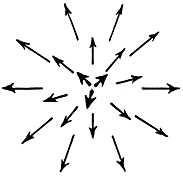
Figure 12A. Hedgehog defect.
Magnets have no line defects (you can't lasso a basketball), but do have
point defects. Here is shown the hedgehog defect,
M(x)= M0 x/|x|.
You can't surround a point defect in three dimensions with a loop, but
you can enclose it in a sphere. The order parameter space, remember,
is also a sphere. The order parameter
field takes the enclosing sphere and maps it onto the order parameter
space, wrapping it exactly once. The point defects in magnets are
categorized by this wrapping number: the second Homotopy group
of the sphere is Z, the integers.
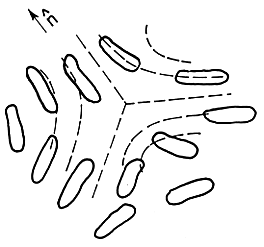

Figure 12B. Defect line in a nematic liquid crystal.
You can't lasso the sphere, but you can lasso a hemisphere! Here
is the defect corresponding to the path shown in
figure 5 (reproduced at right).
As you pass clockwise around the defect line, the order parameter rotates
counterclockwise by 180 degrees.
This path on figure 5 would actually have wrapped around the
right-hand side of the hemisphere. Wrapping around the left-hand
side would have produced a defect which rotated clockwise by 180 degrees.
(Imagine that!) The path in figure 5 is halfway in between, and
illustrates that these two defects are really not different topologically.
Before we explain why these curves form a group, let's give some more examples of topological defects and how they can be classified. Figure 12A shows a ``hedgehog'' defect for a magnet. The magnetization simply points straight out from the center in all directions. How can we tell that there is a defect, always staying far away? Since this is a point defect in three dimensions, we have to surround it with a sphere. As we move around on this sphere in ordinary space, the order parameter moves around the order parameter space (which also happens to be a sphere, of radius M0 = |M|). In fact, the order parameter space is covered exactly once as we surround the defect. This is called the wrapping number, and doesn't change as we wiggle the magnetization in smooth ways. The point defects of magnets are classified by the wrapping number:
![]()
![]() (
(
 ) = Z. (7)
) = Z. (7)
Here, the 2 subscript says that we're studying the second Homotopy group. It represents the fact that we are surrounding the defect with a 2-D spherical surface, rather than the 1-D curve we used in the crystal.
You might get the impression that a strength 7 defect is really just seven strength 1 defects, stuffed together. You'd be quite right: occasionally, they do bunch up, but usually big ones decompose into small ones. This doesn't mean, though, that adding two defects always gives a bigger one. In nematic liquid crystals, two line defects are as good as none! Magnets didn't have any line defects: a loop in real space never surrounds something it can't smooth out. Formally, the first homotopy group of the sphere is zero: you can't loop a basketball. For a nematic liquid crystal, though, the order parameter space was a hemisphere (figure 5, reproduced above). There is a loop on the hemisphere in figure 5 that you can't get rid of by twisting and stretching. It doesn't look like a loop, but you have to remember that the two opposing points on the equater really represent the same nematic orientation. The corresponding defect has a director field n which rotates 180 degrees as the defect is orbited: figure 12B shows one typical configuration (called an s=-1/2 defect). Now, if you put two of these defects together, they cancel. (I can't draw the pictures, but consider it a challenging exercise in geometric visualization.) Nematic line defects add modulo 2, like clock arithmetic in elementary school:
![]()
![]() (
(
 ) =
Z
) =
Z![]() (8)
(8)
Two parallel defects can coalesce and heal, even though each one individually is stable: each goes halfway around the sphere, and the whole loop can be shrunk to zero.
Finally, why are these defect categories a group? A group is a set with a multiplication law, not necessarily commutative, and an inverse for each element. For the first homotopy group, the elements of the group are equivalence classes of loops: two loops are equivalent if one can be stretched and twisted onto the other, staying on the manifold at all times. For example, any loop going through the hole from the top (as in the top right-hand torus in figure 13) is equivalent to any other one. To multiply a loop u and a loop v, one must first make sure that they meet at some point (by dragging them together, probably). Then one defines a new loop u x v by traversing first the loop u and then v.

Figure 13. Multiplying two loops.
The product of two loops is given by starting from their intersection,
traversing the first loop, and then traversing the second. The inverse
of a loop is clearly the same loop travelled backward: compose the two
and one can shrink them continuously back to nothing. This definition
makes the homotopy classes into a group.
This multiplication law has a physical interpretation. If two defect
lines coalesce, their homotopy class must of course be given by the
loop enclosing both. This large loop can be deformed into two little
loops, so the homotopy class of the coalesced line defect is the product
of the homotopy classes of the individual defects.
The inverse of a loop u is just the loop which runs along the same path in the reverse direction. The identity element consists of the equivalence class of loops which don't enclose a hole: they can all be contracted smoothly to a point (and thus to one another). Finally, the multiplication law has a direct physical implication: encircling two defect lines of strength u and v is completely equivalent to encircling one defect of strength u x v.
This all seems pretty trivial: maybe thinking about order parameter spaces and loops helps one think more clearly, but are there any real uses for talking about the group structure? Let me conclude this lecture with an amazing, physically interesting consequence of the multiplication laws we described. There is a fine discussion of this in Mermin's article, but I learned about it from Dan Stein's thesis.
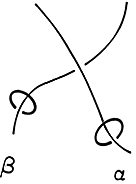
Figure 14A. Defect Entanglement.
Can a defect line of class
![]() pass by a line of class
pass by a line of class
![]() , without
getting topologically entangled?
, without
getting topologically entangled?
Can two defect lines cross one another? Figure 14A shows two defect lines,
of strength (homotopy type)
![]() and
and
![]() , which are
not parallel.
Suppose there is an external force pulling the
, which are
not parallel.
Suppose there is an external force pulling the
![]() defect past the
defect past the
![]() one. Clearly, if we bend and stretch the defect as shown in
figure 14B, it can pass by, but there is a trail left behind, of
two defect lines.
one. Clearly, if we bend and stretch the defect as shown in
figure 14B, it can pass by, but there is a trail left behind, of
two defect lines.
![]() can really leave
can really leave
![]() behind only if
it is topologically possible to erase the trail.
Can the two lines annihilate one another? Only if their net strength is
zero, as measured by the loop in 14B.
behind only if
it is topologically possible to erase the trail.
Can the two lines annihilate one another? Only if their net strength is
zero, as measured by the loop in 14B.
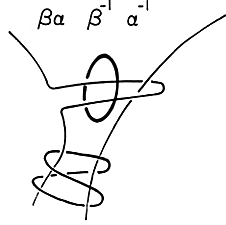
Figure 14B.
We see that we can pass by if we leave
a trail: is the connecting double line topologically trivial? Encircle the
double line by a loop. The loop can be wiggled and twisted off the double
line, but it still circles around the two legs of the defects
![]() and
and
![]() .
.
Now, get two wires and some string. Bend the wires into the shape found in figure 14B. Tie the string into a fairly large loop, surrounding the doubled portion. Wiggle the string around, and try to get the string out from around the doubled section. You'll find that you can't completely remove the string, (No fair pulling the string past the cut ends of the defect lines!) but that you can slide it downward into the configuration shown in 14C.
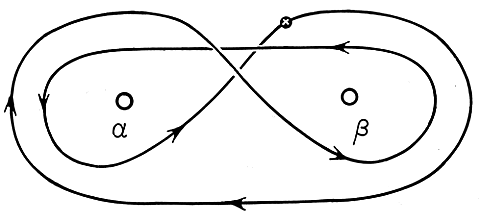
Figure 14C.
(c) The homotopy class of the loop is precisely
![]()
![]()
![]()
![]()
![]()
![]() ,
which is trivial precisely when
,
which is trivial precisely when
![]()
![]() =
=
![]()
![]() .
Thus two defect lines can pass by one another if their homotopy classes commute!
.
Thus two defect lines can pass by one another if their homotopy classes commute!
Now, in 14C we see that each wire is encircled once clockwise and once
counterclockwise. Don't they cancel? Not necessarily! If you look
carefully, the order of traversal is such that the net homotopy class
is
![]()
![]()
![]()
![]()
![]()
![]() ,
which is only the identity if
,
which is only the identity if
![]() and
and
![]() commute. Thus the physical entanglement problem
for defects is directly connected to the group structure of the loops:
commutative defects can pass through one another, noncommutative
defects entangle.
commute. Thus the physical entanglement problem
for defects is directly connected to the group structure of the loops:
commutative defects can pass through one another, noncommutative
defects entangle.
I'd like to be able to tell you that the work hardening in copper is
due to topological entanglements of defects. It wouldn't be true.
The homotopy group of dislocation lines in fcc copper is commutative.
(It's rather like the 2-D square lattice: if
![]() =
(m,n) and
=
(m,n) and
![]() = (o,p)
with m,n,o,p the number of extra horizontal and
vertical lines of atoms, then
= (o,p)
with m,n,o,p the number of extra horizontal and
vertical lines of atoms, then
![]()
![]() = (m+o,n+p) =
= (m+o,n+p) =
![]()
![]() .
The reason dislocation lines in copper don't pass through one another
is energetic, not topological. The two dislocation lines interact
strongly with one another, and energetically get stuck when they
try to cross. Remember at the beginning of the
lecture, I said that there were gaps in the system: the topological
theory can only say when things are impossible to do, not when they are
difficult to do.
.
The reason dislocation lines in copper don't pass through one another
is energetic, not topological. The two dislocation lines interact
strongly with one another, and energetically get stuck when they
try to cross. Remember at the beginning of the
lecture, I said that there were gaps in the system: the topological
theory can only say when things are impossible to do, not when they are
difficult to do.
I'd like to be able to tell you that this beautiful connection between the commutativity of the group and the entanglement of defect lines is nonetheless is important in lots of other contexts. That too would not be true. There are two types of materials I know of which are supposed to suffer from defect lines which topological entangle. The first are biaxial nematics, which were thoroughly analyzed theoretically before anyone found one. The other are the metallic glasses, where David Nelson has a theory of defect lines needed to relieve the frustration. We'll discuss closely related theories in lecture 3. Nelson's defects don't commute, and so can't cross one another. He originally hoped to explain the freezing of the metallic glasses into random configurations as an entanglement of defect lines. Nobody has ever been able to take this idea and turn it into a real calculation, though.
Enough, then, of the beautiful and elegant world of homotopy theory: let's begin to think about what order parameter configurations are actually formed in practise.
![]() Statistical Mechanics: Entropy, Order Parameters, and Complexity,
now available at
Oxford University Press
(USA,
Europe).
Statistical Mechanics: Entropy, Order Parameters, and Complexity,
now available at
Oxford University Press
(USA,
Europe).